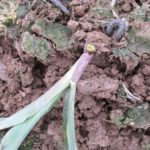We’ve had a pretty good run of cutworms in some fields, but we’ve also had some mistaken identity where armyworms have actually been the problem. This has been in situations where wheat cover crop was infested with armyworms. If the cover crop is killed close to or after planting, there is potential for armyworms to feed on emerging seedlings and cause injury similar to cutworms. I’d recommend using a pyrethroid Continue reading
All posts by Scott Stewart, West TN Research & Education Center
Thrips Update in Cotton
Thus far, reports are that thrips populations have been relatively light but picking up. The forecast model (http://climate.ncsu.edu/CottonTIP) has been predicting that cotton planted after May 15th will face the highest infestations of tobacco thrips, and it appears accurate. Having said that, Continue reading
Reminder – UT Cotton Scout School (Thursday, May 24th) at Milan
The University of Tennessee Cotton Scout School will be held Thursday, May 24th, at the Agricultural Museum at the Research and Education Center in Milan (3A Ledbetter Gate Road, Milan, TN 38358). There is no fee, and preregistration is not required. Registration begins at 8:00 AM with the program starting at 8:45. Content will include hands-on training with an optional ‘go-to-the-field session’ after a box lunch. Topics covered will include cotton development, identification of insects (and their damage) weed and diseases and their damage, and weed identification.
Please note that this is a new location because of ongoing renovation at the Jackson Office.
Corn Insect Update (Aphids, etc.)
There is nothing of great concern going on, but I wanted to mention one thing I am getting some calls about. Corn leaf aphids are being found on seedling corn, more than likely moving from weedy grasses that were in the field. This is nothing to get too excited about. It is unlikely these infestations will hurt yield. It does suggest that insecticide seed treatments are no longer working. This is not surprising in many cases because it took two or more weeks for much of out early planted corn to emerge. This does make a point that Continue reading
Armyworms in Wheat etc.
Be alert for true armyworm infestations in wheat, and these larvae may also migrate into soybean, corn or other crops from adjacent wheat fields of grassy ditch banks. They might even be on weedy grasses or wheat or other grasses used in cover crops, and this could cause a problem if Continue reading
Scout Corn for Cutworms

Much of our corn took a long while to emerge, and there has been opportunity for cutworms to infest fields since planting. Hence, make sure to scout for cutworm injury while checking stands. UT recommends treating for cutworms in corn when 5% or more of plants are injured or when you find 2 or more larvae per 100 plants. Synthetic pyrethroids are generally used to control infestations. Recommended insecticides and rates are listed here.
Planning Ahead for Thrips Control in Cotton
I’m re-running this post as we start planting cotton in Tennessee. If you believe the thrips forecast models developed by NCSU, and my experience is that it works well, then thrips populations are behind schedule. Thus, if we can get some cotton planted in the next 7-14 days, there is a good chance the cotton can outrun thrips before populations peak. Of course, weather is still a significant factor in how badly thrips impact seedlings.
Thrips Infestation Predictor for Cotton – http://climate.ncsu.edu/CottonTIP
Our options for thrips control in Tennessee are mostly unchanged, but there are some key points Continue reading
Sorghum Hybrids with Tolerance to Sugarcane Aphid
Linked below is a list of sorghum hybrids that have exhibited at least some tolerance to the sugarcane aphid. This was shared by Brent Bean of the Sorghum Checkoff program. To be included on this list, the seed company first must recommend the hybrid as having sugarcane aphid tolerance. Second, there must be independent data, usually from university or USDA trials, that confirm tolerance. Check the Sorghum Checkoff website under hybrid selection for updates to the list. It is important to note that some hybrids will have more tolerance than others. Also, just because a hybrid in on the list does not mean it is suitable for our geography.
2018 Sorghum Hybrids with SCA Tolerance
